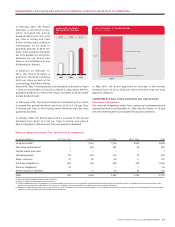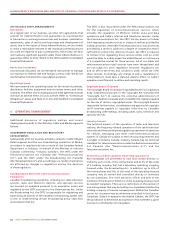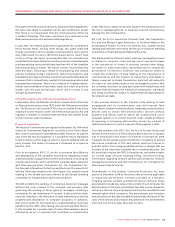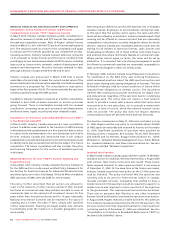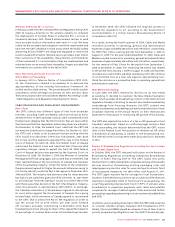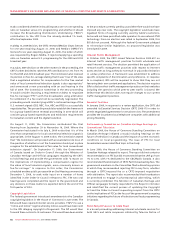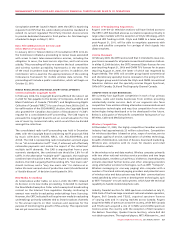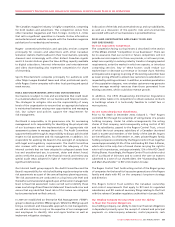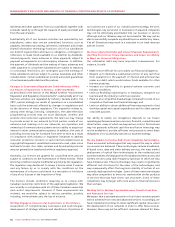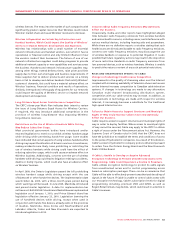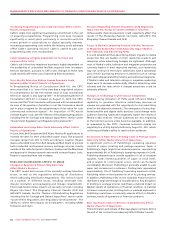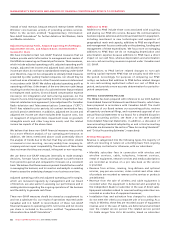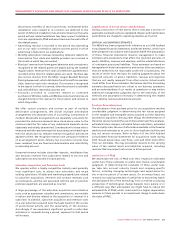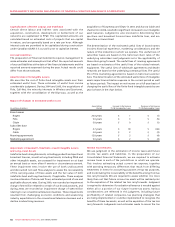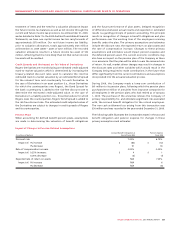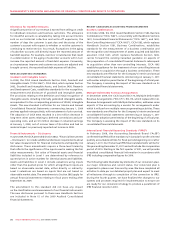Rogers 2009 Annual Report Download - page 56
Download and view the complete annual report
Please find page 56 of the 2009 Rogers annual report below. You can navigate through the pages in the report by either clicking on the pages listed below, or by using the keyword search tool below to find specific information within the annual report.
60 ROGERS COMMUNICATIONS INC. 2009 ANNUAL REPORT
MANAGEMENT’S DISCUSSION AND ANALYSIS OF FINANCIAL CONDITION AND RESULTS OF OPERATIONS
our business are a part of our overall business strategy. Services,
technologies, key personnel or businesses of acquired companies
may not be effectively assimilated into our business or service
offerings and our alliances may not be successful. We may not be
able to successfully complete any divestitures on satisfactory terms,
if at all. Divestitures may result in a reduction in our total revenues
and net income.
We Have Substantial Debt and Interest Payment Requirements
that May Restrict our Future Operations and Impair our Ability
to Meet our Financial Obligations.
Our substantial debt may have important consequences. For
instance, it could:
• Makeitmoredifcultforustosatisfyournancialobligations;
• Require us todedicateasubstantialportionof anycashow
from operations to the payment of interest and principal due
under our debt, which would reduce funds available for other
business purposes;
• Increase our vulnerability to general adverse economic and
industry conditions;
• Limitourexibilityinplanningfor,orreactingto,changesinour
business and the industry in which we operate;
• Placeusatacompetitivedisadvantagecomparedtosomeofour
competitors that have less financial leverage; and
• Limitourabilitytoobtainadditionalnancingrequiredtofund
working capital and capital expenditures and for other general
corporate purposes.
Our ability to satisfy our obligations depends on our future
operating performance and on economic, financial, competitive and
other factors, many of which are beyond our control. Our business
may not generate sufficient cash flow and future financings may
not be available to provide sufficient net proceeds to meet these
obligations or to successfully execute our business strategy.
We Are Subject to Various Risks from Competing Technologies.
There are several technologies that may impact the way in which
our services are delivered. These technologies include broadband,
IP-based voice, data and video delivery services; the mass market
deployment of optical fibre technologies to the residential and
business markets; the deployment of broadband wireless access; and
wireless services using radio frequency spectrum to which we may
have limited access. These technologies may result in significantly
different cost structures for the users of the technologies, and
may consequently affect the long-term viability of certain of our
currently deployed technologies. Some of these new technologies
may allow competitors to enter our markets with similar products
or services that may have lower cost structures. Some of these
competitors may be larger with more access to financial resources
than we have.
We May Fail to Achieve Expected Revenue Growth from New
and Advanced Services.
We expect that a substantial portion of our future revenue growth
will be achieved from new and advanced services. Accordingly, we
have invested and continue to invest significant capital resources in
the development of our networks in order to offer these services.
However, there may not be sufficient consumer demand for these
dividends and other payments from our subsidiaries together with
proceeds raised by us through the issuance of equity and debt and
from the sale of assets.
Substantially all of our business activities are operated by our
subsidiaries, other than certain centralized functions, such as
payables, remittance processing, call centres, real estate, and certain
shared information technology functions. All of our subsidiaries
are distinct legal entities and have no obligation, contingent or
otherwise, to make funds available to us whether by dividends,
interest payments, loans, advances or other payments, subject to
payment arrangements on intercompany advances. In addition,
the payment of dividends and the making of loans, advances and
other payments to us by these subsidiaries are subject to statutory
or contractual restrictions, are contingent upon the earnings of
those subsidiaries and are subject to various businesses and other
considerations. Certain subsidiaries provide unsecured guarantees
of our bank and public debt and Derivatives.
Changes in Government Regulations Could Adversely Affect
Our Results of Operations in Wireless, Cable and Media.
As described in the section of this MD&A entitled “Government
Regulation and Regulatory Developments”, substantially all of our
business activities are regulated by Industry Canada and/or the
CRTC, and accordingly our results of operations on a consolidated
basis could be adversely affected by changes in regulations and
by the decisions of these regulators. This regulation relates to,
among other things, licencing, competition, the cable television
programming services that we must distribute, wireless and
wireline interconnection agreements, the rates we may charge
to provide access to our network by third parties, resale of our
networks and roaming on to our networks, our operation and
ownership of communications systems and our ability to acquire an
interest in other communications systems. In addition, the costs of
providing services may be increased from time-to-time as a result
of compliance with industry or legislative initiatives to address
consumer protection concerns or such Internet-related issues as
copyright infringement, unsolicited commercial e-mail, cyber-crime
and lawful access. Our cable, wireless and broadcasting licences
may not generally be transferred without regulatory approval.
Generally, our licences are granted for a specified term and are
subject to conditions on the maintenance of these licences. These
licencing conditions may be modified at any time by the regulators.
The regulators may decide not to renew a licence when it expires
and any failure by us to comply with the conditions on the
maintenance of a licence could result in a revocation or forfeiture
of any of our licences or the imposition of fines.
The licences include conditions requiring us to comply with
Canadian ownership restrictions of the applicable legislation. We
are currently in compliance with all of these Canadian ownership
and control requirements. However, if these requirements are
violated, we would be subject to various penalties, possibly
including, in the extreme case, the loss of a licence.
We May Engage in Unsuccessful Acquisitions or Divestitures.
Acquisitions of complementary businesses and technologies,
development of strategic alliances and divestitures of portions of



